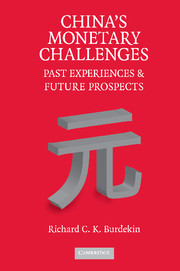Book contents
- Frontmatter
- Contents
- Preface
- Introduction: China Today and Lessons from the Past
- PART I CHINA'S EXCHANGE RATE REGIME AND MONETARY POLICY
- PART II THE IMPORTANCE OF INTERNATIONAL FACTORS, PAST AND PRESENT
- PART III THE PEOPLE'S REPUBLIC'S ROLE WITHIN GREATER CHINA AND ASIA
- 8 Asset Market Expansion and Shanghai vs. Hong Kong Listings of Chinese Firms
- 9 Economic Interdependence with Taiwan
- 10 Conclusions and Future Prospects for the Renminbi
- References
- Author Index
- Subject Index
9 - Economic Interdependence with Taiwan
Published online by Cambridge University Press: 06 July 2010
- Frontmatter
- Contents
- Preface
- Introduction: China Today and Lessons from the Past
- PART I CHINA'S EXCHANGE RATE REGIME AND MONETARY POLICY
- PART II THE IMPORTANCE OF INTERNATIONAL FACTORS, PAST AND PRESENT
- PART III THE PEOPLE'S REPUBLIC'S ROLE WITHIN GREATER CHINA AND ASIA
- 8 Asset Market Expansion and Shanghai vs. Hong Kong Listings of Chinese Firms
- 9 Economic Interdependence with Taiwan
- 10 Conclusions and Future Prospects for the Renminbi
- References
- Author Index
- Subject Index
Summary
“Made by Taiwan but made in China” would be a new expression to describe the global division of labor across the Taiwan Strait driven by Taiwanese businesspeople's direct investment in China.
(Tung, 2004, p. 6)Introduction
This chapter examines the relationship between mainland China and Taiwan both in terms of trade integration and flows of foreign direct investment and in terms of overall macroeconomic interdependence as represented by output, money, inflation, and financial market interrelationships. There has been striking ongoing growth in trade linkages and investments flows in the years since Taiwan's government eased its blanket restrictions on interactions with mainland China in 1985. These trade flows also accelerated sharply after mainland China and Taiwan each joined the World Trade Organization (WTO) around the end of 2001. The importance of Taiwanese foreign direct investment, however, clearly remains understated in official data. Limits imposed by Taiwan's government on allowed investments in the mainland have sparked considerable Taiwan-led investments entering the mainland via third areas like Hong Kong, the British Virgin Islands, and the Cayman Islands. This trend is reflected in the fact that official figures of foreign direct investment inflows to mainland China (otherwise inexplicably) rank the British Virgin Islands second in importance only to Hong Kong. The cumulative total of Taiwanese foreign direct investment in mainland China through 2007 may actually have reached $US 150 billion.
- Type
- Chapter
- Information
- China's Monetary ChallengesPast Experiences and Future Prospects, pp. 188 - 218Publisher: Cambridge University PressPrint publication year: 2008



